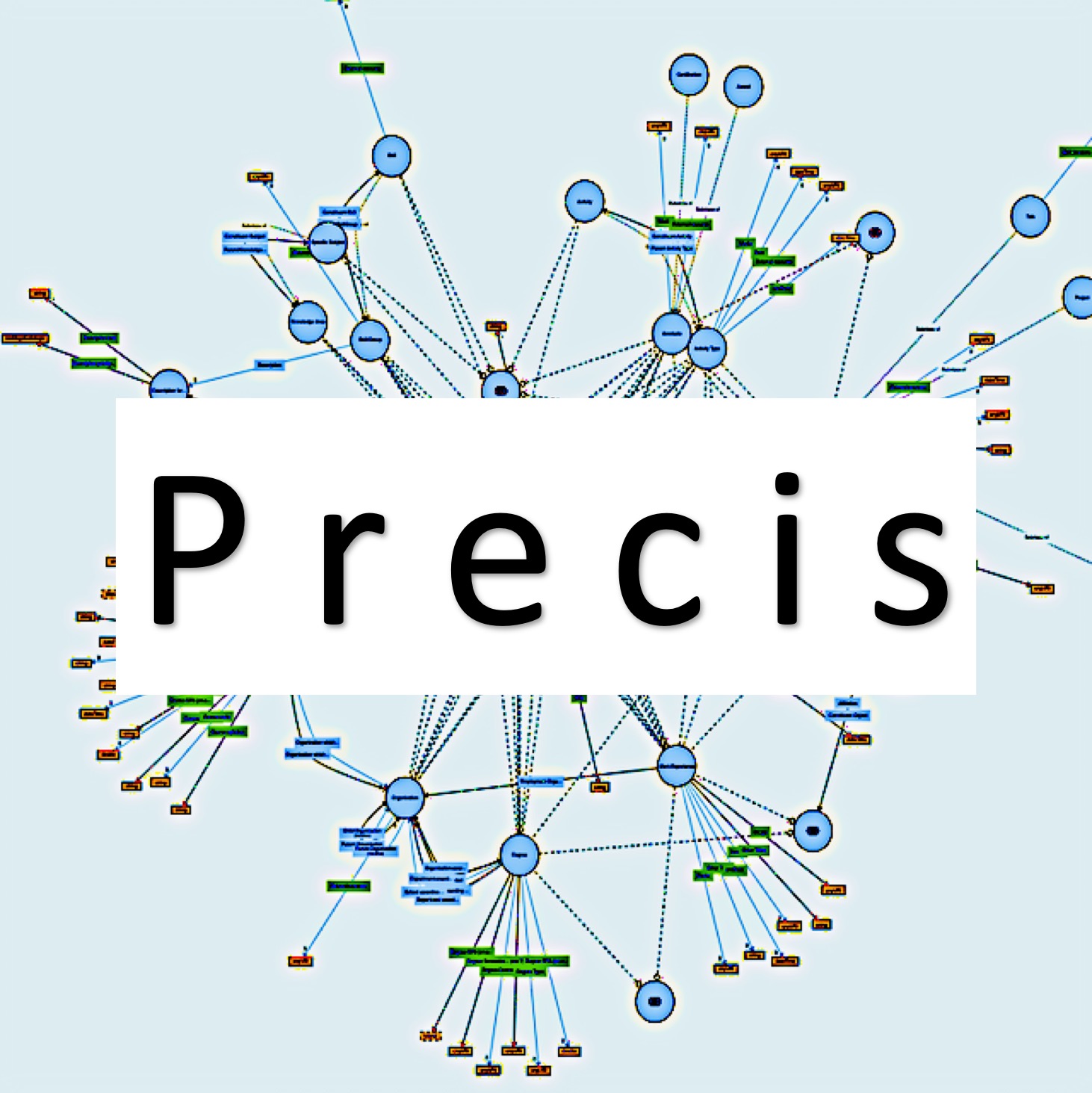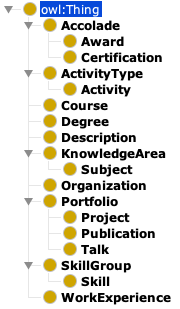precis

A personal professional metadata ontology and toolkit
Precis Ontology Structure
This document describes the structure of the Precis ontology. Note that this information is not necessary to use the Precis toolkit. It is here primarily for reference, and for anyone that wants to understand how the ontology is structured at a deeper level.
Note 1: This document also has JSON schema descriptions (not a complete JSON Schema for now…) for each of the Concepts outlined in the Ontology. This information is not necessary to understand the Precis ontology structure, and is provided for reference purposes.
Note 2: Unless otherwise stated, the
$idfield in JSON schema descriptions is optional. If left blank, the precis toolkit will auto-generate an ID on JSON ingestion. This will also mean that the instance in question will be un-referenceable, as a random ID will be generated upon ingestion.
Note 3: The list of attributes described in the class JSON schema in this document are not exhaustive, and do not necessarily imply a required attribute of the given class.
Overall Structure

Concepts (i.e. Classes)
This subsection describes each of the top-level concepts (or classes) in the Ontology. The heading level corresponds to the concept’s position in the ontology class structure.
Accolade
This concept is an umbrella class for anything that can be construed as an accolade of some sort. In the case of a traditional portfolio, this would be something that is classified as an award or certification; hence the current subclasses.
No concepts should be instantiated as an Accolade, but rather as one of its subclasses; Award or Certification. Thus, there is no construction information for this umbrella class.
Award
{
"$id": "User-defined ID",
"inMonth": "Month the award was received",
"externalResource": ["List of external resources"],
"affiliatedWith": "ID of Degree/WorkExperience instance that this award is affiliated with",
"hasDescription": ["List of Description objects corresponding to this instance"],
"hasMedia": ["List of media (URLs) for media related to this instance"],
"inYear": "Year the award was received",
"hasName": "Name (for human consumption)",
"relatedTo": "Related instances; can be anything in Precis"
}
This concept describes what may traditionally be described as an “award”.
For example, this class would encapsulate something like “Dean’s List”, or “1st Place in Hackathon X”. Note that in the case of the second example, it would be related to a “Hackathon”, which would be linked using the relatedTo object property.
Certification
{
"$id": "User-defined ID",
"inMonth": "Month the certification was received",
"externalResource": ["List of external resources"],
"affiliatedWith": "ID of Degree/WorkExperience instance that this certification is affiliated with",
"hasDescription": ["List of Description objects corresponding to this instance"],
"hasMedia": ["List of media (URLs) for media related to this instance"],
"inYear": "Year the certification was received",
"hasName": "Name (for human consumption)",
"relatedTo": "Related instances; can be anything in Precis"
}
This concept describes what may traditionally be described as a “certification”.
For example, this class would encapsulate something like “CPR Certification”, or “Bloomberg Market Concepts Certificate”. Note that in the case of the second example, it would be related to a Course, Degree or Organization, which would be linked using the relatedTo property.
ActivityType
{
"$id": "User-defined ID",
"inMonth": "Month the certification was received",
"externalResource": ["List of external resources"],
"hasDescription": ["List of Description objects corresponding to this instance"],
"hasMedia": ["List of media (URLs) for media related to this instance"],
"inYear": "Year the certification was received",
"hasName": "Name (for human consumption)",
"relatedTo": "Related instances; can be anything in Precis"
}
This concept would describe a “type” of Activity.
That is, it should be treated as an umbrella class to describe a set of activities that can be relegated to a specific “type”. Examples of this would include a “Hackathon” ActivityType, which be a superclass to many individual instances of Hackathons.
Activity
{
"$id": "User-defined ID",
"inMonth": "Month the Activity was completed",
"externalResource": ["List of external resources"],
"hasDescription": ["List of Description objects corresponding to this instance"],
"hasMedia": ["List of media (URLs) for media related to this instance"],
"inYear": "Year the Activity was completed",
"hasName": "Name (for human consumption)",
"relatedTo": "Related instances; can be anything in Precis"
}
This concept describes a specific Activity.
This should be an instance of a specific ActivityType. That is, it would be a specific Hackathon (which would in turn be a subclass of the “Hackathon” ActivityType).
Course
{
"$id": "User-defined ID",
"externalResource": ["List of external resources"],
"hasDescription": ["List of Description objects corresponding to this instance"],
"hasName": "Name (for human consumption)",
"taughtAt": "Precis Organization instance that this course was taught at",
"withGrade": "Grade received for this course",
"hasWebsite": "Website for the course",
"hasDepartmentCode": "Department code (eg: FIN, CSE, etc.)",
"hasCourseCode": "Course code (eg: 423, 142, etc.)"
}
This concept describes a specific Course.
As stated in the name, this describes a course. This doesn’t necessarily have to be associated with a specific Degeree, which provides flexibility to include things like Coursera/edX courses.
Degree
{
"$id": "User-defined ID",
"degreeConcentration": "Concentration of the Degree (URI to external concept)",
"degreeDepartment": "Precis organization corresponding to the awarding department (eg: Department of Finance/Department of Computer Science)",
"degreeGPA": "GPA of the degree (necessarily optional 🙃🔫)",
"degreeSchool": "Precis organization corresponding to the awarding School (not University, but rather the College/School housing the Department, eg: School of Business, College of Engineering, etc.)",
"degreeType": "Type of the degree (URI to external concept, eg: BA, MS, PhD, etc.)",
"degreeUniversity": "Precis organization corresponding to the University (eg: University of Washington, Stevens Institute of Techonlogy, etc.)",
"hasName": "Name (for human consumption)",
"inCity": "City in which the degree was awarded",
"inState": "State [or Country] in which the degree was awarded",
"monthAwarded": "Month in which the degree was awarded",
"yearAwarded": "Year in which the degree was awarded"
}
This concept describes a Degree.
Contrary to how this is traditionally represented on a CV, think of this as a container, encapsulating a set of organizations that awarded the Degree (i.e. the Department, School/College, and University). In addition to linking all of these related organizations with relevant object relation descriptors, this class also stores traditional information associated with a degree, such as the Degree type, title, etc.
Description
{
"hasText": "Text of the Description",
"hasPriority": "Priority level of this particular description (for ordering on display; optional)"
}
This is a Description block. Instances of this is what should be included in the list of “hasDescription”, where it is mentioned in the classes of the Ontology.
KnowledgeArea
{
"$id": "User-defined ID",
"externalResource": ["List of external resources"],
"hasDescription": ["List of Description objects corresponding to this instance"],
"hasName": "Name (for human consumption)"
}
This concept describes a Knowledge Area.
This is intentionally ambiguous, as the definition of a “Knowledge Area” will probably vary widely by user, and their current domain of expertise. For me personally, examples of this would be “Mathematics”, “Computer Science”, and “Finance”.
Subject
{
"$id": "User-defined ID",
"externalResource": ["List of external resources"],
"hasDescription": ["List of Description objects corresponding to this instance"],
"hasName": "Name (for human consumption)"
}
This concept describes a specific Subject.
Again, as with KnowledgeArea, this is intentionally ambiguous. Using my personal examples again, this would be along the lines of “Non-Convex Optimization”, and “Advanced Probability Theory” in the “Mathematics” KnowledgeArea, “Scientific Computing” and “Object Oriented Design” in the “Computer Science” KnowledgeArea, and finally “Portfolio Theory” and “Market Microstructure” in the “Finance” KnowledgeArea.
Organization
{
"$id": "User-defined ID",
"externalResource": ["List of external resources"],
"hasDescription": ["List of Description objects corresponding to this instance"],
"hasName": "Name (for human consumption)",
"hasParentOrganization": "Reference to another Precis organization that would represent a Parent organization (for example, the 'Department' Organization at a University would have a parent organization pointing to the 'University'",
"hasWebsite": "Organization website"
}
This concept describes an Organization. This is pretty self explanatory.
Portfolio
{
"$id": "User-defined ID",
"affiliatedWith": "Reference to Precis Degree/WorkExperience that this Portfolio item is affiliated with",
"inMonth": "Month the Portfolio item was completed",
"externalResource": ["List of external resources"],
"hasDescription": ["List of Description objects corresponding to this instance"],
"hasMedia": ["List of media (URLs) for media related to this instance"],
"inYear": "Year the Activity was completed",
"hasName": "Name (for human consumption)",
"hasWebsite": "Corresponding website",
"relatedTo": "Related instances; can be anything in Precis"
}
This concept is a high level generalization of a “Portfolio” item. For Precis, this means a Project, Publication, or Talk. However, this may be expanded later to include more items in the same taxon as the examples listed.
Note that subclasses of Portfolio (as with all others too) inherit all of the attributes of the superclass. The following subclass descriptions only list unique attributes not already required by Portfolio.
Project
{
"hasCollaborators": "Collaborators formatted as a string"
}
This would describe a Project, such as something done at a Hackathon (which would in turn be related to the Hackathon using the relatedTo object property), or a random personal project like this (Precis).
Publication
{
"hasAuthors": "Formatted author list (single string)",
"hasDOI": "External DOI of the publciation",
"hasStatus": "Current status of the publication (eg: Under Review, In Progress, etc.)",
"inConferenceOrJournal": "Publication Conference proceedings/Journal",
"inPublication": "Publication that the given paper is published in",
"inYear": "Year"
}
This describes a (typically, though not exclusively, peer-reviewed) Publication.
Talk
{
"hasCollaborators": "Collaborators as formatted string",
"inYear": "Year"
}
This describes a Talk.
SkillGroup
{
"$id": "User-defined ID",
"externalResource": ["List of external resources"],
"hasDescription": ["List of Description objects corresponding to this instance"],
"hasName": "Name (for human consumption)"
}
This describes a SkillGroup.
As with the KnowledgeArea/Subject concepts, this too is left to be intentionally ambiguous, as its definition and usage will vary significantly by User. To use a personal example again, instances of SkillGroup for me would be “Programming Languages”, “Machine Learning Tools and Frameworks”, and “Other Skills”.
Skill
{
"$id": "User-defined ID",
"externalResource": ["List of external resources"],
"hasName": "Name (for human consumption)"
}
This describes a specific Skill, belonging to a SkillGroup.
To continue the example (applying to me personally) from above, this would be “R” and “Python” in the “Programming Languages” SkillGroup, and “Public Speaking” and “Extensive Writing Experience” in the “Other Skills” category.
WorkExperience
{
"$id": "User-defined ID",
"inState": "State of employment",
"inCountry": "(Alternative to 'inState') Country of employment",
"inCity": "City of employment",
"employedAt": "Precis organization corresponding to the employer",
"startMonth": "Month the job started",
"startYear": "Year the job started",
"endMonth": "Month the job ended",
"endYear": "Year the job ended",
"hasDescription": ["List of Description objects corresponding to this instance"],
"hasImage": "URL to image",
"hasMedia": ["List of media (URLs) for media related to this instance"],
"jobTitle": "Job title"
}
This describes a specific WorkExperience, and similar to Degree, it includes a pointer to a Precis Organization corresponding to the employer.